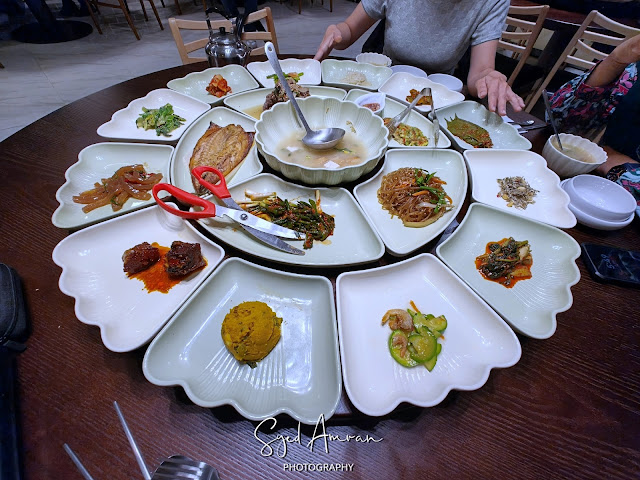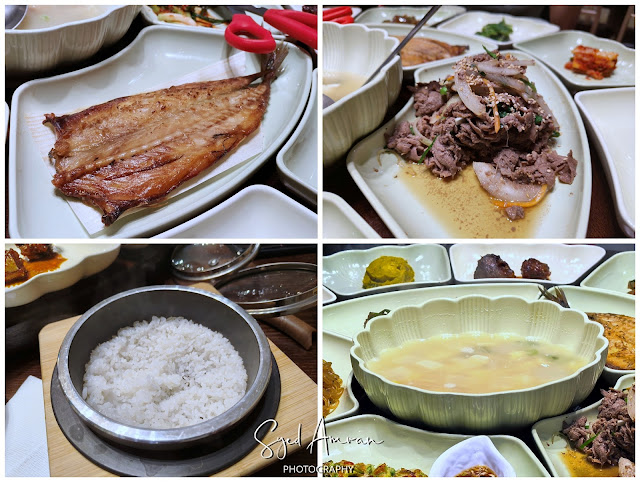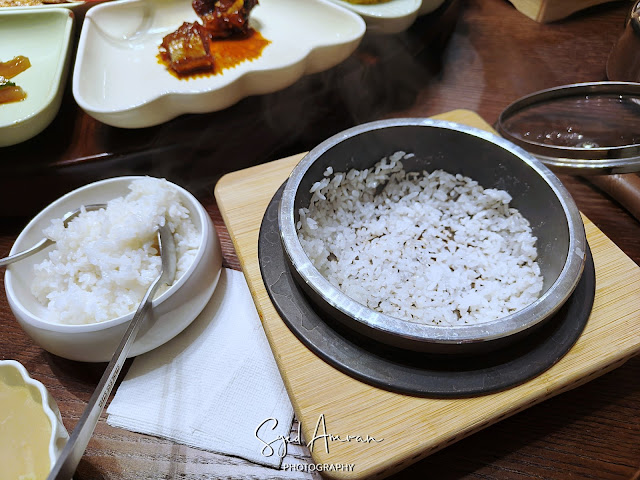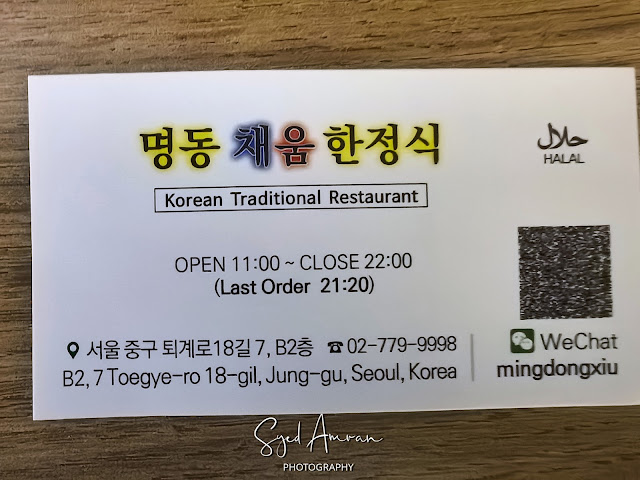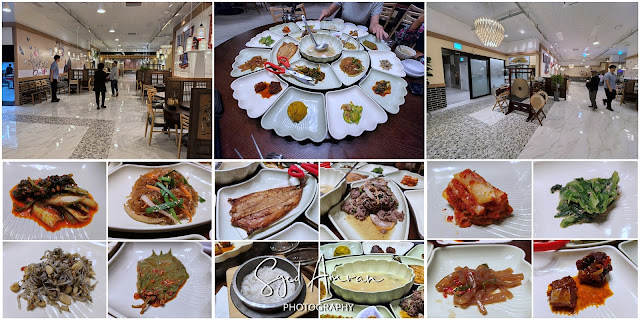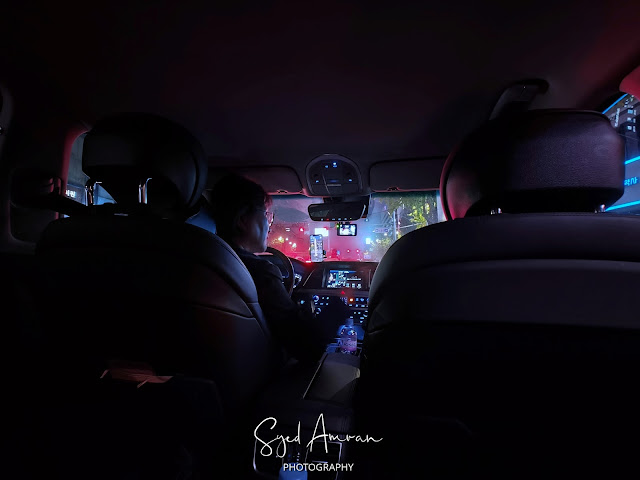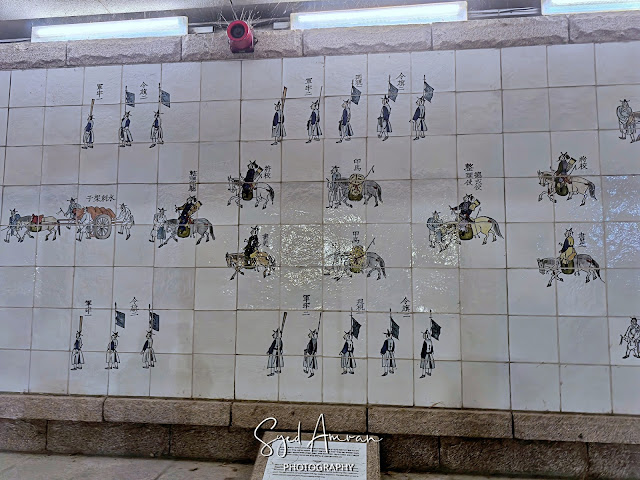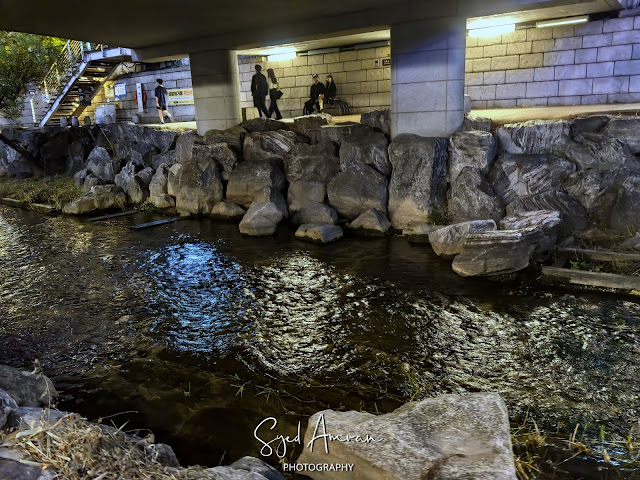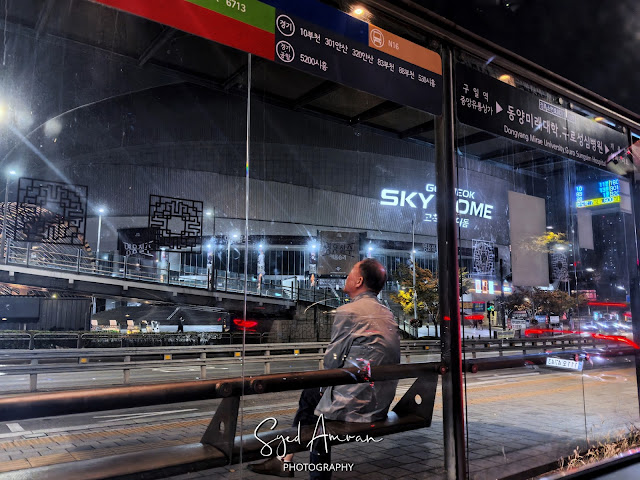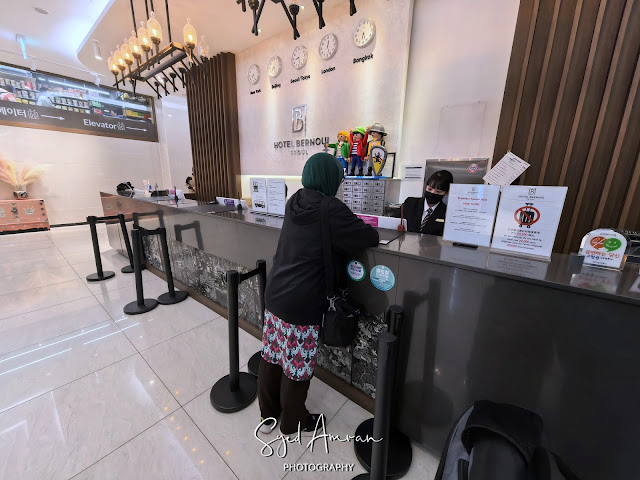Assalamualaikum
🔵Dari Meyongdong Street Market, seterusnya Clara bawa kami ke restoran untuk makan malam.
🔵Untuk ke restoran kami jalan kaki sahaja. Dekat saja, dalam 10 minit jalan kaki.
🔵Makan malam kami pada hari itu sangat istimewa kerana kami dibawa makan malam di Halal Korean Traditional Restaurant di Myeongdong.
🔵명동 채움한정식 means Myeongdong Chaeum Hanjeongsik.
🔵Entrance restoran.
🔵Suasana dalam restoran.
🔵The staff and kitchen.
🔵The restaurant is beautifully decorated with many Korean traditional elements. There is a gong. The drum-like instruments on either side are called janggu.
🔹Gong: A gong is a percussion instrument originating from Southeast Asia, widely used in various musical traditions across East and Southeast Asia. It is typically a circular, flat or bowl-shaped metal disc, often struck with a mallet to produce a resonant sound.
🔹Janggu: A janggu is a traditional Korean drum, characterized by its hourglass shape and two distinct drumheads, each producing a different pitch when struck
🔵Kelihatan beberapa meja makan dengan pelanggan Muslim. Nampaknya mereka dari Malaysia juga.
🔵Berbual dengan Clara sambil menunggu makanan tiba.
🔵Yang seronoknya masa kami bercuti di Korea ini, ketiga-tiga tour guides kami di Busan (Sarah), Pulau Jeju (Mr. Lucas) dan Seoul (Clara), semua bawa kami jalan-jalan sampai ke malam, sampai makan malam dan dihantar ke hotel. Meaning, mereka tidaklah clock-in 9 to 5.
🔵Inilah makan malam kami yang pada kami cukup istimewa sekali. Kami memanglah teringin nak makan makanan authentic dan tradisional Korean, dan tentunya mestilah nak yang halal.
🔵Nama hidangan ini ialah Hanjeongsik.
🔵Hanjeongsik, also known as Korean table d'hôte, is a traditional Korean full-course meal characterized by a variety of side dishes (banchan) and other dishes served together.
🔹It's a culinary experience that showcases the art of Korean cuisine and is often associated with special occasions and celebrations.
🔹Diverse Array of Dishes: Hanjeongsik typically includes a wide array of banchan (small side dishes), main dishes, and soups, all presented together on the table.
🔹Traditional and Formal: Historically, Hanjeongsik was reserved for royalty and aristocrats, highlighting its significance in Korean culture.
🔹Emphasis on Balance and Harmony: The meal is designed to offer a balance of flavors, textures, and colors, reflecting the Korean concept of Yin and Yang.
🔹Sharing and Hospitality: Hanjeongsik is meant to be shared, emphasizing the importance of communal dining and hospitality in Korean culture.
🔹Not Just a Meal, but an Experience: It's not just about the food; Hanjeongsik provides a glimpse into Korean culinary heritage and is a feast for the eyes as well as the palate.
🔹Modern Interpretations: While traditionally served with all dishes at once, some modern Hanjeongsik may present the dishes in a course-like manner.
🔵Boss restoran ini sendiri yang menghidangkan makan malam kami. So nice of him. Ketika ini dia sedang mencedokkan sup ke dalam mangkuk untuk kami.
🔹Mangkuk pertama diberikan kepada saya kerana kata Clara, ikut tradisi orang Korea, the head of the family should be served first.
🔹Ya, mengikut nilai tradisional Korea, ketua keluarga biasanya dihidangkan makanan terlebih dahulu.
🔹Amalan ini berakar umbi dalam Konfusianisme dan menekankan penghormatan kepada orang tua dan struktur hierarki dalam keluarga.
🔹Ahli keluarga tertua, selalunya bapa atau datuk, biasanya yang pertama menerima dan mula makan, menandakan authority dan peranan mereka sebagai ketua.
🔵Myeongdong Chaeum Hanjeongsik serves a traditional Korean full-course meal called Hanjeongsik, which includes a variety of dishes.
🔹The main dishes are typically selected from options like Braised Beef Short Ribs (Galbi-jjim) or Soy Sauce Marinated Crab (Ganjang Gejang), with a basic option also available.
🔹The meal features a lavish spread of side dishes (banchan), soups, stews, and rice.
🔵Here's a more detailed look at what you can expect:
🔹Main Dishes: You'll choose from options like Braised Beef Short Ribs (Galbi-jjim), Soy Sauce Marinated Crab (Ganjang Gejang), or a basic main dish.
🔹Banchan (Side Dishes): A wide array of small, flavorful side dishes are served, often including kimchi, seasoned vegetables, and other Korean delicacies.
🔹Soups and Stews: Expect hearty and flavorful soups or stews to accompany your meal.
🔹Rice: A staple in Korean cuisine, rice is served with the meal to complete the experience.
🔹Other potential dishes: Depending on the specific menu and seasonal offerings, you might also find dishes like steamed crab, marinated octopus, pumpkin porridge, seasonal salads, and more.
🔹Grilled Fish (생선구이, Saengseon-gui): The upper left image shows a whole grilled fish, likely a common inclusion in Hanjeongsik meals, which often feature various protein options.
🔹Marinated Beef (불고기, Bulgogi or similar): The upper right image features a dish of sliced, marinated beef, a staple in Korean cuisine and frequently part of a Hanjeongsik spread.
🔹Steamed Rice (밥, Bap): The lower left image clearly shows a bowl of steamed white rice, which is the foundation of any Korean meal, including Hanjeongsik.
🔹Stew or Soup (찌개/국, Jjigae/Guk): The lower right image presents a large bowl of what appears to be a stew or soup, such as Doenjang Jjigae (soybean paste stew) or another type of clear or hearty soup, which are integral parts of a Hanjeongsik meal.
🔹Top Left: Pa-kimchi (Green Onion Kimchi) - a type of kimchi made with green onions, seasoned with a spicy red chili paste.
🔹Top Right: Japchae (Stir-fried Glass Noodles) - a dish made with sweet potato starch noodles, stir-fried with various vegetables and sometimes meat, typically seasoned with soy sauce and sesame oil.
🔹Bottom Left: Myeolchi Bokkeum (Stir-fried Anchovies) - a common Korean side dish consisting of stir-fried dried anchovies, often with nuts like peanuts or almonds, seasoned with soy sauce, sugar, and sesame oil.
🔹Bottom Right: Kkaennip Kimchi (Perilla Leaf Kimchi) - a type of kimchi made from fermented perilla leaves, often seasoned with a spicy sauce.
🔹Top Left: Likely a type of Jeon (Korean pancake), possibly Pajeon (scallion pancake) or Buchujeon (chive pancake), served with a dipping sauce.
🔹Top Right: Appears to be a type of Kimchi, potentially Pa-kimchi (green onion kimchi) or another leafy green kimchi variant.
🔹Bottom Left: Resembles Ojingeo-chae muchim (seasoned dried shredded squid) or another namul (seasoned vegetable side dish).
🔹Bottom Right: A banchan (side dish) featuring green beans and a shrimp, possibly a stir-fried or seasoned vegetable dish with seafood.
🔹Top Left: Kimchi (likely Baechu Kimchi). This is a traditional side dish of salted and fermented napa cabbage with a variety of seasonings, including chili powder, garlic, and ginger.
🔹Top Right: Namul. This refers to a variety of seasoned vegetable side dishes, often lightly blanched or stir-fried and seasoned with ingredients like sesame oil, garlic, and soy sauce.
🔹Bottom Left: Japchae. This is a savory and slightly sweet dish of stir-fried glass noodles (made from sweet potato starch) and vegetables, often including mushrooms, carrots, and spinach.
🔹Bottom Right: Jangjorim. This is a savory Korean side dish made by braising beef (or sometimes other proteins like quail eggs) in a soy sauce-based broth until tender.
🔹Top Left: Kimchi or a similar fermented vegetable dish, possibly a type of 'pa kimchi' (green onion kimchi) or 'buchu kimchi' (garlic chive kimchi), often served with scissors for cutting.
🔹Top Right: Hobak Beombeok (Korean Pumpkin Mash), a sweet and savory dish made with mashed pumpkin, beans, and sometimes other ingredients.
🔹Bottom Left: Saewoo Hobak Bokkeum (Stir-fried Shrimp and Zucchini), a common side dish featuring shrimp and sliced zucchini.
🔹Bottom Right: Gyeran Jjim (Steamed Egg Custard), a soft and fluffy savory egg dish, often served in a bowl.
🔵Clara also taught us the traditional way of eating rice.
🔹In the Korean way, rice is served to everyone in a hotpot.
🔹Because the rice is served piping hot, some of it will crust over, especially on the bottom.
🔹After the rice is transferred to a bowl to be eaten, the remaining rice crust in the hotpot is soaked in hot water that is served with the meal to make rice porridge.
🔹This rice porridge is eaten at the end of the meal.
🔹This practice was originally introduced by Buddhist monks who did not want to waste the food they were given.
🔹Hot water is poured into the hotpot to soften the remaining rice crust.
🔹Then cover the hotpot with a lid to retain the heat to be eaten at the end of the meal.
🔵We were gifted souvenirs by the restaurant owner. How nice of them 😃.
🔵Here's the restaurant card, if you are interested. Memang saya recommend makan di restoran ini jika ke Seoul as you'll get to taste authentic and traditional Korean food. Dan yang paling penting ialah makanannya halal.
🔵While singing bowls are not originally Korean, they have been integrated into Korean culture and sound healing practices, particularly in yoga and meditation settings.
🔹Korean practitioners use Tibetan singing bowls, among others, to enhance meditation, induce relaxation, and promote holistic well-being.
🔵The owner also briefly explained to us about these instrument.
🔵I was also invited to hit the gong with a mallet 😄.
🔵I had to do it the second time because apparently the first was not hard or loud enough 😆.
🔵Bergambar kenangan bersama boss restoran dan isteri dia. They are such nice couple. They were the ultimate gracious hosts.
🔵The main question, is it delicious? To us it is indeed! Sedap!😋. From the cozy restaurant ambiance, not only the Hanjeongsik is beautifully presented visually but also delicious to the wonderfully personalized service, I must say this restaurant is up there in my top 5 best restaurants I have visited so far.
🔹The Hanjeongsik at Myeongdong Chaeum Hanjeongsik was an incredible experience! The sheer variety of banchan, from spicy kimchi to fresh vegetable dishes, was impressive.
🔹We loved the fresh, flavorful dishes and the beautiful presentation of the Hanjeongsik. It was a true taste of Korean cuisine.
🔹Definitely worth the visit! The Hanjeongsik at Myeongdong Chaeum Hanjeongsik is a must-try for anyone wanting to experience a traditional Korean feast.
🔵We left this wonderful restaurant feeling full and satisfied. Alhamdulillah.
🔵A group of tourist just walked in as we were leaving the restaurant.
🔵The image shows a vibrant "SEOUL" art installation in Myeongdong, South Korea, part of the "Jaemiro" (재미로) project.
🔹Location: This artwork is located on Jaemiro, a "Manga Street" in Myeongdong, Jung-gu, Seoul, which is a cultural content cluster centered around the former Seoul Animation Center.
🔹Artist Collaboration: The installation is a collaboration with Korean graphic artist Grafflex, known for his unique style blending graffiti, street art, and character design.
🔹Theme: The project transforms the street into a large canvas, signifying the rebirth of the city and featuring playful and vibrant art, including characters like "minini".
🔵Bergambar kenangan di Myeongdong, Seoul.
🔵Myengdong at night.
🔵Sebelum menghantar kami ke hotel, Clara cadang kami lawat ke Cheonggyecheon Stream dulu. Tentulah kami setuju 😃.
🔵Cheonggyecheon Stream mempunyai banyak pintu masuk dan Clara menurunkan kami di Pintu 7.
🔵Cheonggyecheon Stream is a restored, 11-kilometer-long urban oasis in the heart of Seoul, South Korea.
🔹Originally a neglected waterway, it was transformed into a public space with pedestrian walkways, waterfalls, and public art, offering a tranquil escape from the city's hustle and bustle.
🔹The stream flows through the city center, connecting various attractions and providing a scenic route for walking and relaxation.
🔵Key Features and Information:
🔹Restoration Project: The stream was restored in the early 2000s, with the removal of an elevated highway and the implementation of ecological and urban renewal strategies.
🔹Urban Renewal Symbol: The restoration of Cheonggyecheon is considered a symbol of Seoul's successful urban renewal and revitalization efforts.
🔹Attractions: The stream features various attractions along its length, including waterfalls, public art installations, footbridges, and recreational areas.
🔹Accessibility: The stream is easily accessible with multiple entry points and stairways, and some entrances even have elevators.
🔹Public Space: It is a popular spot for locals and tourists to enjoy a peaceful stroll, admire the scenery, and experience a connection with nature within the city.
🔹Water Source: The stream's water is recycled and pumped from the Han River.
🔹Night View: The stream is particularly beautiful at night, with lights illuminating the waterfalls and creating a peaceful ambiance.
🔹Events: Cheonggyecheon Stream is also used for various events and festivals, further enhancing its appeal.
🔵Historical Context:
🔹Pre-Restoration: The stream was historically a natural waterway that was eventually covered by an elevated highway in the 1970s due to urbanization and increased traffic.
🔹Urban Oasis: The restoration project aimed to revitalize the area, improve the environment, and create a waterfront in the downtown area.
🔹Ecological Park: The restored stream is now considered an ecological park, with increased biodiversity and a thriving ecosystem.
🔵Nearby Attractions:
🔹Cheonggye Plaza: The starting point of the stream, featuring the "Spring" sculpture and a popular cultural arts venue.
🔹Dongdaemun Design Plaza (DDP): A futuristic architectural landmark known for its design and exhibitions.
🔹Gwangjang Market: A traditional Korean market known for its street food and local crafts.
🔹Gyeongbokgung Palace: One of Seoul's grandest and most iconic palaces.
🔵Cheonggyecheon Stream ialah sebuah oasis bandar yang menarik, berubah daripada laluan air yang diabaikan dan tercemar kepada ruang awam yang meriah.
🔵Projek pemulihan yang dilakukan telah meningkatkan biodiversiti di kawasan ini dengan ketara, dengan peningkatan mendadak dalam bilangan spesies tumbuhan, ikan, burung dan invertebrata.
🔵Pemulihan Cheonggyecheon dianggap sebagai contoh pemulihan ekologi bandar yang berjaya dan simbol komitmen Seoul untuk mewujudkan ruang hijau di dalam bandar.
🔵Cheonggyecheon Stream features beautiful man-made mini-waterfalls as part of its urban renewal project.
🔹These waterfalls, along with the stream itself, offer a tranquil escape in the heart of the city, adding to the aesthetic appeal and providing a soothing soundscape.
🔵Pemulihan sungai ini juga menambah baik kawalan banjir di kawasan sekitarnya.
🔵Cheonggyecheon Stream is a popular filming location for various K-dramas, movies, and even music videos. The stream's romantic ambiance and scenic views make it a favorite spot for filming romantic scenes and date sequences.
🔵This tile mural is a replica of the "Banchado of King Jeongjo," a historical document illustrating King Jeongjo's royal procession to visit his father's tomb in Hwaseong (Suwon) in 1785. It is reportedly one of the largest tile wall paintings in the world, comprised of over 5,000 tiles.
🔵It depicts King Jeongjo's 1795 journey from Changdeokgung Palace in Seoul to Hwaseong Fortress and his parents' tomb in Suwon, commemorating the 60th birthday of his mother, Queen Heongyeong.
🔵King Jeongjo was the 22nd king of the Joseon Dynasty, reigning from 1776 to 1800, known for his academic prowess and reform efforts.
🔵Joseon Dynasty royal processions were grand public displays of the king's authority and power, often involving elaborate ceremonies, music, and a large entourage.
🔹These processions served multiple purposes, including demonstrating the king's majesty, connecting with the populace, and reinforcing Confucian ideals of rule.
🔵Information plaque.
🔵Queen Hyegyeonggung's husband was King Jeongjo, the 22nd ruler of the Joseon Dynasty. He reigned from 1776 to 1800.
🔹Queen Hyegyeonggung, originally known as Lady Hyegyeong, was the Crown Princess during the reign of her father-in-law, King Yeongjo.
🔹She became the Queen Consort upon her husband's accession to the throne in 1776.
🔵The "Banchado of King Jeongjo" is a large-scale tile painting depicting King Jeongjo's royal procession to Hwaseong (Suwon) in 1795, during the Joseon Dynasty.
🔹Originally, the Banchado is a 60-page illustrated historical document of the royal procession.
🔹It is a reproduction of a detailed documentary painting, the Wonhaeng Eulmyo Jeongni Uigwe, which meticulously records the eight-day journey to visit his father's tomb.
🔹It illustrates a scene from the "Uigwe" (의궤), which are detailed royal protocols documenting important court ceremonies and events, including royal processions.
🔹The painting is composed of 5,120 individual ceramic tiles and is known as the largest tile painting in the world.
🔹This large-scale ceramic tile mural replicating this painting along Cheonggyecheon Stream in Seoul, measures 186 meters in length and 2.3 meters in height, making it the world's largest ceramic mural.
🔹Banchado" (반차도) refers to detailed record paintings of state ceremonies during the Joseon Dynasty, illustrating the precise arrangement and positions of participants and objects.
🔵Key aspects of the Banchado:
🔹Royal Procession: The painting vividly portrays the elaborate procession, including King Jeongjo, his mother Hyegyeonggung Hong, musicians, flag-bearers, court ladies, and soldiers.
🔹Historical Significance: The event commemorated in the Banchado was a significant one, showcasing King Jeongjo's filial piety and his commitment to strengthening royal authority and improving the lives of his people.
🔹Artistic Merit: The original painting, created by renowned artists of the Joseon era, including Kim Hongdo, is a masterpiece of meticulous record-keeping and artistic skill. The royal procession details include the officials, guards, and equipment involved.
🔹Recreation: The tile painting is a faithful recreation of the original, capturing the details of the procession and the layout of Seoul (Suseonjeondo).
🔹Filial Piety and Empathy: King Jeongjo's visits to his father's tomb were not just ceremonial, they were opportunities to connect with his subjects and address their concerns, demonstrating his empathy and concern for their well-being.
🔹Cultural Asset: The Banchado is considered a valuable cultural asset, providing insights into the history, art, and social structure of the Joseon Dynasty.
🔵This particular image shows a palanquin (tandu) being carried as part of a royal procession, King Jeongjo's journey to Hwaseong to visit his father, Crown Prince Sado's tomb.
🔵The scale and detail of this tile mural convey the grandeur and importance of this historical event.
🔵Tall, modern skyscrapers with illuminated windows rise in the background, contrasting with the dark night sky. Trees with visible foliage add a touch of nature to the scene, and the overall atmosphere is one of a vibrant city landmark at night.
🔵Historically, Cheonggyecheon played a role in Seoul's early sewerage system, and its restoration represents a successful urban renewal project.
🔵Once a polluted stream, now a modern and vibrant public recreational urban green space, offering a tranquil environment for walking, picnicking, and enjoying the urban landscape, with various art installations and cultural events held along its banks.
🔵Selesai jalan-jalan kami tunggu Clara menjemput kami di Pintu 7.
🔵After finishing our first day's tour program in Seoul, Clara took us to our hotel, Bernoui Hotel Seoul.
🔵Hotel Bernoui, which was our accommodation during our stay in Seoul, is located in an area called Guro District which is quite far from the city center of Seoul.
🔵Pemandangan malam bandaraya Seoul.
🔵Gocheok Sky Dome is South Korea's first domed baseball stadium, located in Seoul.
🔹It serves as the home field for the Kiwoom Heroes baseball team and also functions as a large-scale concert and performance venue.
🔹The stadium can hold 16,744 spectators for baseball games and around 25,000 for concerts.
🔵Guro Fire Station.
🔹Sampai di hotel terus saja kami check-in. Letih seharian jalan-jalan sampai malam dan nak cepat masuk bilik.
🔹Tapi reception kata booking bilik kami tiada dalam sistem mereka. Pulak.
🔹No choice, terpaksalah kami call Rebecca (agent kami di Malaysia) lagi untuk minta bantuan.
🔹Rebecca call travel agent Korea, travel agent Korea call hotel. 10 minit dah settle.
🔹Dapat kunci, kami terus naik ke bilik.
🔹Drama la sikit 😄.
🔹Alhamdulillah.
🔵Lobi hotel.
🔵Bilik penginapan di Hotel Bernoui Seoul.
🔵Luas dan selesa.
To be continued.
Till the next coming entry, inshaAllah. Meanwhile do take care.
No photograph or videos may be reproduced, downloaded, copied, stored, manipulated, or used whole or in part of a derivative work, without written permission from Syed Amran. All rights reserved.

























